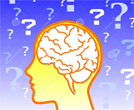Monday, 1 February 2016
Two Scientific Models Called into Question

Every scientific theory consists of models that can be used to generate hypotheses that can be tested by observation or experimentation. If the observations or experimental results are inconsistent with what the models predict, then the models themselves must be called into question. Recent developments in neuroscience provide two examples of models that are going to have to be adjusted to such “abnormal data”, as Thomas Kuhn has called them.
* * *
The first example concerns Broca’s area, which is part of the frontal cortex and has traditionally been associated with the production of spoken language, while Wernicke’s area, which lies in the temporal lobe, has traditionally been associated with the understanding of spoken language, and human language functions have been thought to be explained by the coherent activity of these two areas working together. This somewhat simplistic dichotomy was already the subject of some debate, because it was already known that other brain circuits also are involved in language, and that the role of Broca’s area was far more complex than just producing speech.
But now a study published in the Proceedings of the National Academy of Sciences in February 2015 has shown that when we are producing the sounds associated with a word, Broca’s area actually goes silent! This area would thus seem to be associated not with producing speech as such (which is presumably handled by other, adjacent motor areas), but rather with integrating and co-ordinating information from various other parts of the brain.
The authors were able to make this distinction by studying patients with epilepsy who had had electrodes implanted in their brains in preparation for surgery. These electrodes provided very accurate recordings of the patients’ neuronal activity, enabling the authors to determine that when the patients were having a conversation, the neurons in Broca’s area seemed to fire not when the patients were actually speaking (as was formerly believed), but rather while they were mentally preparing the sentences that they were about to speak.
* * *
The second example comes from a study published in Neuroscience & Biobehavioral Reviews. This study questions nothing less than the dominant theory that, for almost half a century, has been used to explain the mode of action and the effect of selective serotonin reuptake inhibitors (SSRIs), a type of antidepressant medication and one of the most widely sold kinds of medication in the world.
According to the existing theory, depression is associated with abnormally low production of serotonin, a neurotransmitter that some neurons use to communicate with one another, and SSRI molecules offset this low production by blocking a mechanism that removes the serotonin from the synapses between neurons, so that it stays there longer.
In those patients in whom SSRIs are effective, the benefits take a few weeks to be felt. But in the meantime, the patients’ morale often gets worse. The authors of this study therefore wondered whether these drugs might not in fact ultimately slow down the brain’s natural recovery mechanisms. According to these authors, more serotonin may actually be released and used during episodes of depression (but such data can be obtained only by indirect measurement, hence the controversy).
The authors think that serotonin may thus actually help the brain to adapt to depression, by redirecting the organ’s resources to what might be called “conscious thoughts”, at the expense of other, less conscious processes. Depression, even though it is always painful and difficult, would thus be seen as a beneficial adaptation of the organism to its situation, an adaptation with its own resolution mechanisms in the brain. This new theory is stimulating an important debate.
* * *
These two examples show that in science, and especially in neuroscience, the only thing that is just about certain is that things always turn out to be less simple than was once believed.
![]() Brain’s iconic seat of speech goes silent when we actually talk
Brain’s iconic seat of speech goes silent when we actually talk
![]() The science behind commonly used anti-depressants appears to be backwards, researchers say
The science behind commonly used anti-depressants appears to be backwards, researchers say
From Thought to Language, Mental Disorders | No comments







